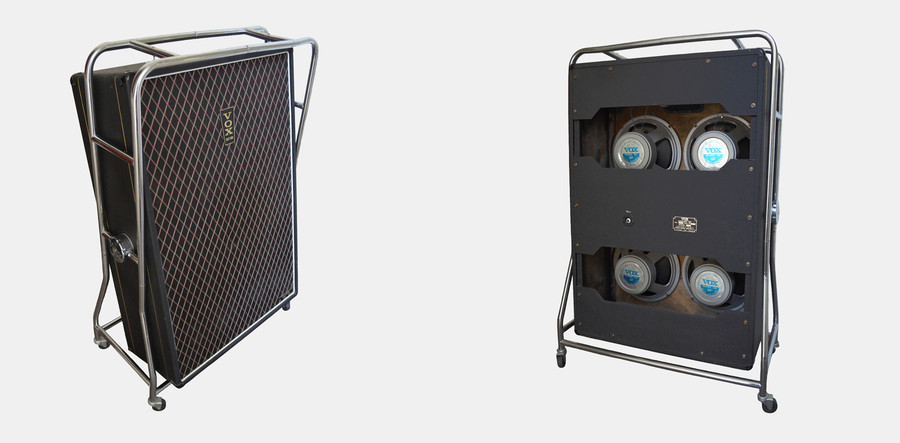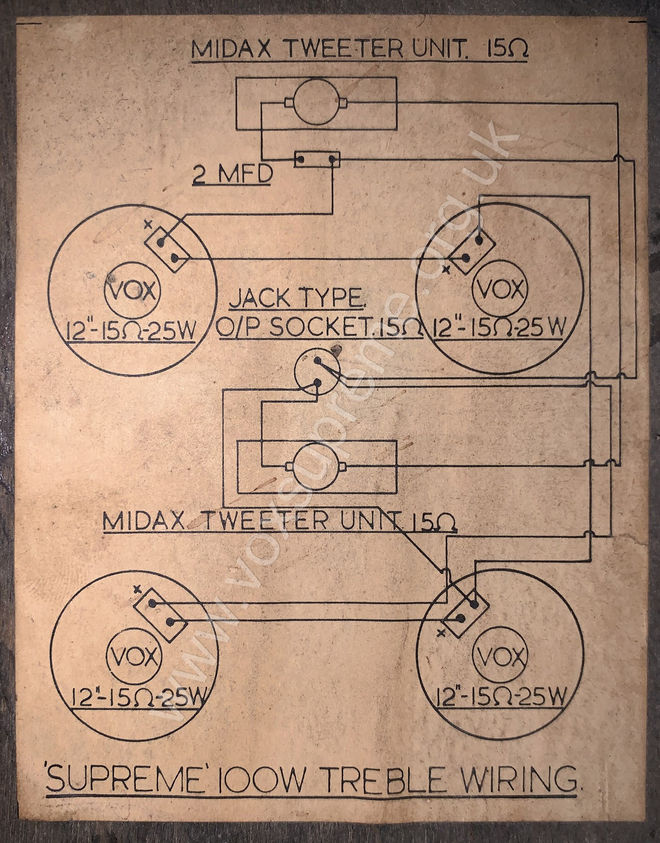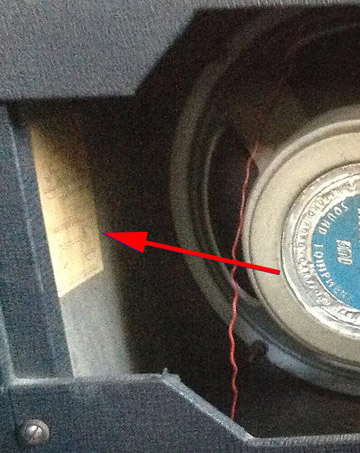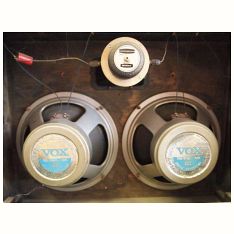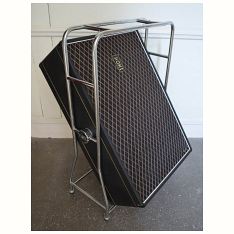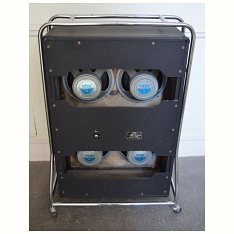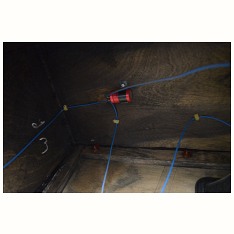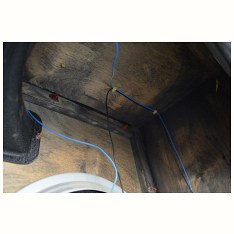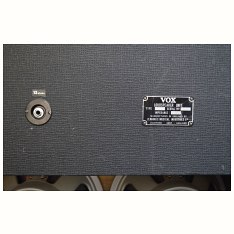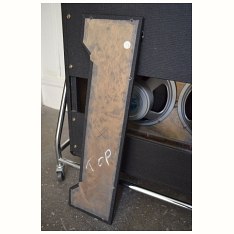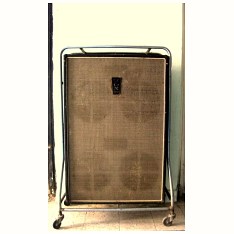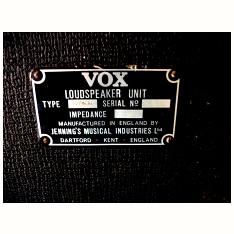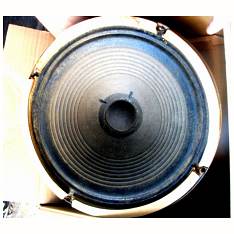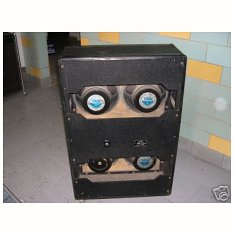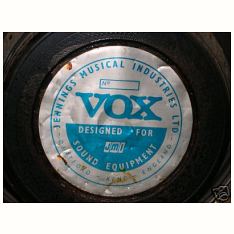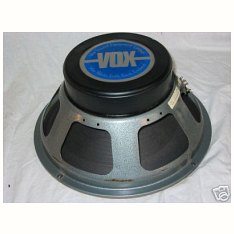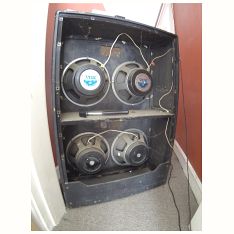VOX SUPREME SPEAKER CABINETS
1967 - 1972
A JMI Supreme speaker cabinet in its trolley. For further images, see below.
DIMENSIONS: 27 1/4 inches wide; 40 inches high; and 11 1/4 inches deep. The cabinets took their form from the AC100: four 12" drivers, and two Goodmans Midax horns protected from bass frequencies by crossover capacitors (2uf). A wiring schema is available here.
The wooden boxes were made by three companies: Gla-Rev, based in Hainault, Essex; P.A. Glock of Crayford; and Heslop & Co. of Rayleigh, Essex. Heslop & Co. labels have so far only been found in amplifier sections, however. Vinyl covering, grille cloth, and fixtures and fittings were added at the Vox Works in Erith. For a picture of a Conqueror speaker cabinet being finished at Erith, see this page.
The drivers at first were Celestion ceramic T1225s (perhaps also T1279s), rated at 20-25W, impedance 15 ohms. In outward appearance, T1225s and T1279s are indistinguishable from each other. Occasionally during the JMI period, Celestion T1360 horns were used instead of the Goodmans Midax, but Goodmans are the norm.
All Supreme cabs had a total impedance of 15ohms, the standard for the solid state range from first designs - see the pre-production page. 8ohm cabs are never found.
Although speaker wiring diagrams have survived reasonably well in Vox Conqueror and Vox Defiant speaker cabinets, only one has so far come to light in a Supreme cab.
Detail from a photo of Mick Jagger standing in front a Supreme amplifier taken on 13th April, 1967, shortly before one of the Stones' performances there. The other picture is of a surviving diagram in an early Supreme speaker cabinet.
More really as a note, just to say that trolleys were provided with "T-nuts" that screwed into threaded holes in the base of the amplifier section, keeping it firmly attached to the bars - an ingenious arrangement.
The "T-nuts" can be seen on the short transverse bars on top of the frame.
In the second third of 1967, Goodmans 241H drivers were brought in for speaker cabinets that had tilt-back stands rather than a full trolley. The speakers have heavy cast iron frames with six spokes, and black dust covers. Vox applied the same blue and silver labels it used for the Celestions. The extra weight of the speakers gave the cabinets a good low centre of gravity - a real asset where the tilt-back stands were concerned.
A typical Supreme tilt-back stand, pictured in the "Vox Sound Equipment Limited" brochure of early 1969. Tilt-backs had first been introduced in late 1967, and sold in reasonable numbers.
In the late Spring of 1968 Jennings Musical Industries folded. A certain amount of its stock, however, passed to a new company - "Vox Sound Equipment Limited", founded in the summer of 1968 by former JMI men - see this page. Celestion T1225s and T1279s evidently formed part of the inherited stock as these drivers crop up now and again in early VSEL Supreme cabs. VSEL also dallied for a short time with Celestion T1096s, the 15ohm version of the alnico T1088 - but T1096s were not a good choice soundwise (having too great a treble response). It is likely that cost soon precluded their use.
From around 1969, Goodmans "Power Range" - with green stickers to denote 15ohms - became the norm and the remained the norm through to 1971. The provisioning of cabs then changed, probably a result of the need to cut costs. The Midax horns were dropped - one finds the openings in the baffle still there, but blanked off - and Celestion Greenback T1925s were brought in as the drivers. These had whizzer cones, making them better for bass or organ than guitar, but open-back cabs (intended more for guitar than anything else) were still supplied with them.
Towards the end of the "Vox Sound Limited" period (early 1970 to late 1972) Supreme speaker cabinets were phased out, and Supreme amplifier sections were issued with Companion cabs instead.
Numbers of cabs produced.
In the JMI period, speaker cabinets could not be purchased alone. Amp and cab came together as a set. Speaker cabinets were therefore not numbered, even though there was space for one on the ID plate. They notionally took the number of the amplifier with which they were sold.
A standard JMI Supreme speaker cabinet ID plate. Very early Conquerors and Defiants were termed respectively the "ST30R" and ST50R". No example has yet surfaced of a Supreme that is termed a "ST100R", but it may be that only a small number were termed and stamped in this way.
1967 to spring 1968 (JMI): approximately 300 Supremes sold. Speaker cabinets were not available separately.
From the beginning of the "Vox Sound Equipment Limited" period on, that is to say from late 1968, amps and cabs could be purchased separately, so speaker cabinets were numbered, the sequence for each model beginning at 001. Amplifiers were numbered from 2000.
Detail from the "Vox Sound Equipment Limited" pricelist of February 1969.
A "Vox Sound Equipment Limited" Supreme speaker cabinet ID plate - serial number 212. The cabinet was issued with Supreme amplifier serial number 2231 in November 1969.
Late 1968 to late 1969 (VSEL): in total around 250. From number 001 to between 236 (highest known VSEL) and 289 (lowest known VSL)
Just as VSEL took over unsold stock from JMI, VSL took stock over from VSEL. One regularly finds VSL speaker cabinets (VSL on the ID plate) that contain speakers with VSEL labels.
One of a group of Supreme speaker cabinets to have been inspected on 11th July 1972 - see this page.
Early 1970 to late 1972 (VSL): in total around 300. From between number 236 and 272, through to 543.
JENNINGS MUSICAL INDUSTRIES
March - early 1968
First generation JMI: "VOX" only in logo: no "Solid State"
The Rolling Stones European Tour, 1967. From left to right: Orebo (March 27th); Cologne (30th March), and Warsaw (April 13th).
Mick Jagger standing in front of Brian Jones's Supreme cab before curtain up at Warsaw, 13th April. A great view of the ceramic Celestion speakers, which were standard at first in all early Supreme cabs.
An early cab. Note the plain silver logo (no "Solid State").
Second generation JMI: "VOX" and "Solid State" in the logo
A JMI Supreme cab from the third quarter of 1967. The logo has "Solid State" beneath "VOX". Drivers are a species of Celestion G12H, 15ohms, heavily doped. A second layer of cork lies over the gasket, so it is not possible to determine the "T" number. The cab is extremely sensitive - it takes comparatively little input to drive it to high volumes. Older photos on this page.
A cab similar to the one above, "Solid State" in the logo, but regrilled. The horns are not Goodmans Midax, however, but Celestion T1360, with date code 07GM = 7th July 1967. The crossover is a set of four resistors on a section of tagboard rather than a 2uf capacitor.
JMI tilt-back stands (and cabinets)
A cab more or less contemporary with the one above. The grille cloth has been changed, but condition is otherwise good. The position of the chrome pivot high up on the side of the re-grilled cab indicates that the trolley was of the tilt-back variety, as in the flyer lower down this page. Again, no serial number stamped on the back plate.
Note that the drivers are black-capped Goodmans Power Range 15 ohm ceramics (rather than Celestions) with old-style labels. Below two Goodmans units from later Vox Supremes.
On the left, c. 1967-1968; on the right c. 1969-71.
The remains of a JMI Supreme cabinet designed for a tilt-back stand. The position of the pivot high up on the side of the cab (surrounded by four screws for the fixing) can be seen in the pictures of the cab's interior. See further on this page. The drivers are Goodmans, reconed as 8ohm units unfortunately, so not ideal.
Above, the Stones at the NME Pollwinners' Concert, Wembley 1968. The Supreme on the far left is of tilt-back design. The ones middle and right of stage have the full trolley, with bars over the top of the cabs.
VOX SOUND EQUIPMENT LIMITED
Summer 1968 - late 1969
The serial number sequence for Vox Supreme speaker cabinets began at 001 and ran through to the end of the "Vox Sound Limited" period (see further below). The lowest VSEL Supreme cab number currently known is 039.
VSEL Supreme speaker cabinet serial number 039. Its speakers are heavy-duty Goodmans with cast iron frames (as in the case of a good number of cabs below). There are no VSEL labels on the black dust covers. The cabinet belongs to Supreme amplifier section 2043 (from factory).
Same Celestion speakers as some of the JMI cabinets further up this page, but the serial plate indicates "Vox Sound Equipment Limited". Marks on the sides show that the frame was a tilt-back stand, rather than a full trolley.
Supreme serial number 2231 with its original speaker cabinet, serial number 212. A picture of its plate can be seen near the top of this page. Note the tilt-back stand and the covers. The speakers are Goodmans (as are the horns). The Supreme was sold in November 1969, invoice dated 26th Nov. '69.
VOX SOUND LIMITED
Early 1970 - late 1972
Supreme speaker cabinet serial number 272. Note the blue-framed Goodmans speakers and the "Vox Sound Equipment Limited" labels.
Speakers with "Vox Sound Equipment Limited" labels, but serial plate for "Vox Sound Limited". The handwheels for the tilt-back stand remain.
Similar to the cab above but with its original tilt-back trolley.
VSL Supreme, serial number 2355. The speaker cabinet is serial number 300, its speakers Celestion G12H T1217s - date codes "FC22", "FC24", and "BD2", respectively 22nd and 24th June, 1970; and 2nd February 1971.
Celestion alnico T1096 speakers. Vox Sound Ltd., serial no. 417. Note the dabs of thick yellow paint over the internal nuts and bolts, typical of Vox Sound. Something is awry with the frame. The side sections are in three parts. It looks as though a tilt-back stand has been modified to accept the upper section of a full trolley.
A Supreme cab from July 1972
A Supreme cab - number 525 - from 1972, with inspection tag and a plasti-leather cover. The drivers are Celestion T1925s, bass resonance (50Hz rather than 55Hz) - code EF, which should mean June 1972 - the inspection tag is dated 11th July 1972. Midax horns have been abandoned. The sides of the cab have both carrying handles and holes for the tilt-back stand. The cover that accompanied was probably designed for a cab with a full trolley - see the last picture.
Another late Supreme cab, with Celestion T1925 drivers and no Midax horns. Serial no. 543, probably one of the last to be made. As in the cab above, there are side handles and above them a hole for the pivot fixing of a tilt-back trolley. In terms of date codes, the T1925s in the upper compartment have "GE" and "JE" (day dates unclear) = respectively July and September 1972.
Below, a late "new-style" tilt-back trolley, a pretty substantial thing. Whether the casters/wheels are original is not certain.
Later the trolleys were dropped, though the fixings for the amplifier section on top of the speaker cabinet were retained.
The section on Companion cabs, made by Vox Sound Ltd in 1971-1972 to accompany Supremes, has now been given a page of its own.
